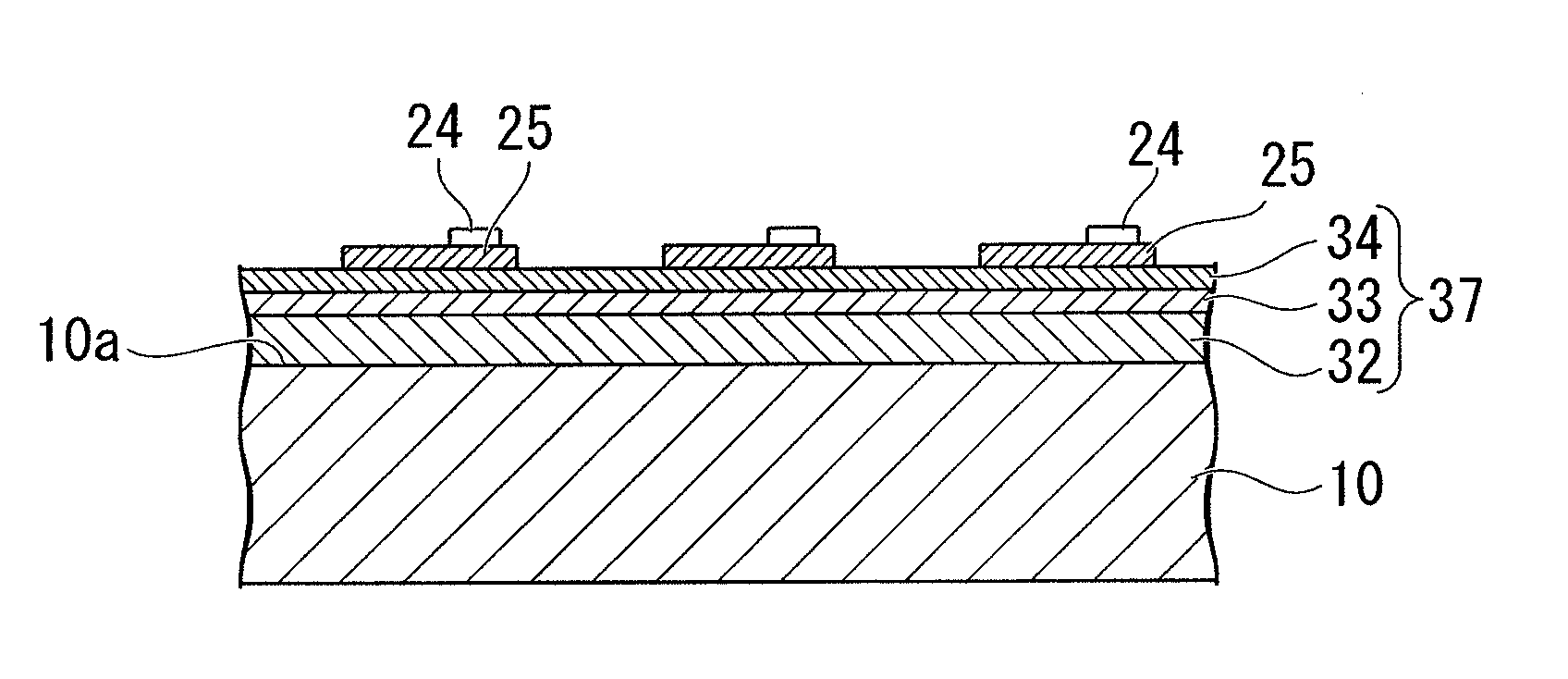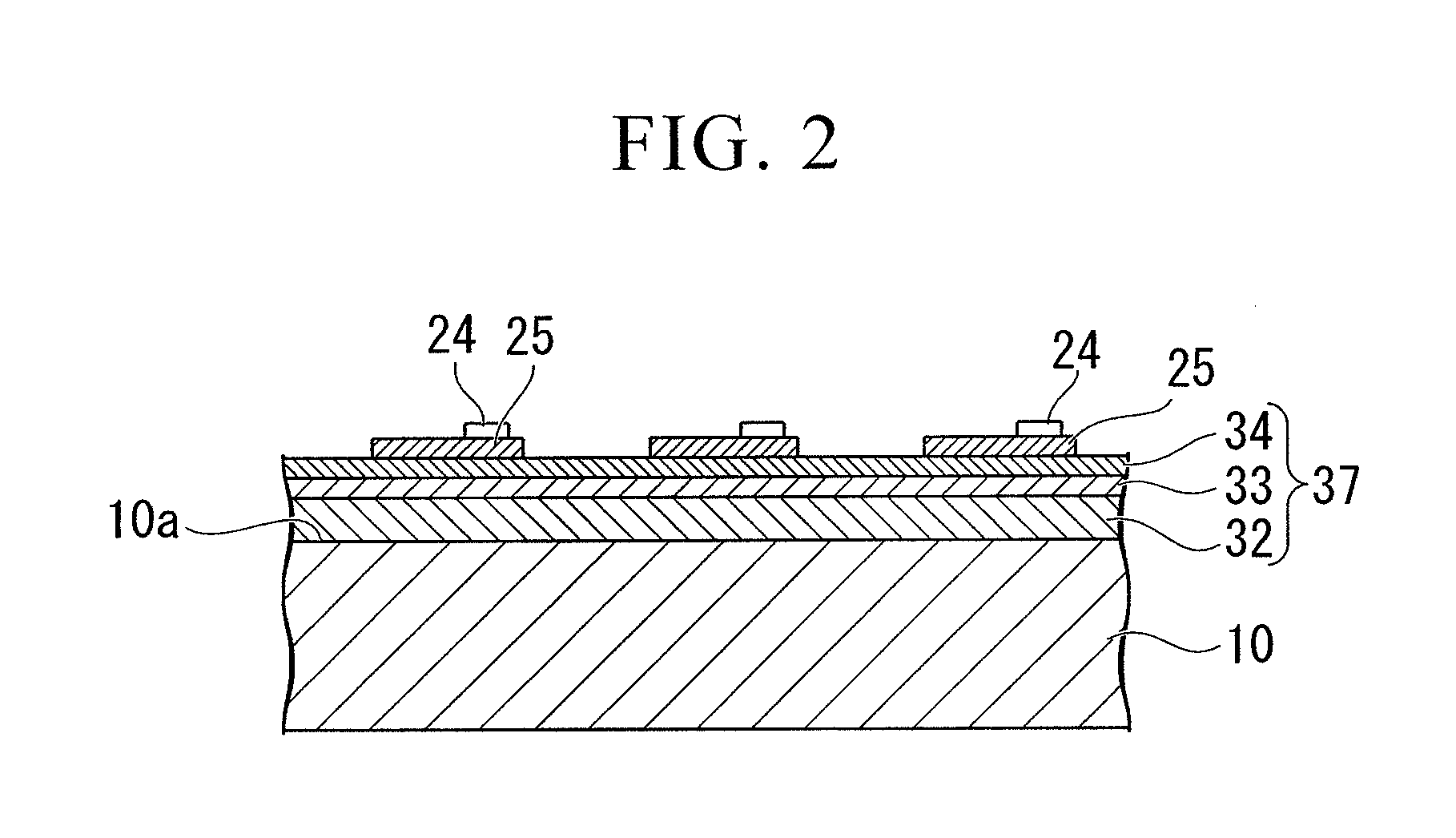Method of manufacturing semiconductor light-emitting device
a technology of light-emitting devices and semiconductors, which is applied in the manufacturing of semiconductor/solid-state devices, semiconductor devices, electrical devices, etc., can solve the problems of easy leakage of led chips, easy cleavage, and the rigidity of the apphire component commonly used as a substrate material of led chips, so as to prevent prevent leakage. , the effect of preventing the occurrence of chipping
- Summary
- Abstract
- Description
- Claims
- Application Information
AI Technical Summary
Benefits of technology
Problems solved by technology
Method used
Image
Examples
first embodiment
[0035]An example of a method of manufacturing a semiconductor light-emitting device which is an embodiment of the invention will be described.
[0036]The method of manufacturing the semiconductor light-emitting device which is an embodiment of the invention includes the steps of forming a plurality of light-emitting device sections, having an approximately rectangular shape in a plan view, on a substrate in a matrix shape (first step), forming a first dividing groove between the long sides of the light-emitting device sections so that the long side of the light-emitting device section is along an easily cleaved plane of the substrate (second step), forming a second dividing groove, having a larger width than the width of the first dividing groove, between the short sides of the light-emitting device sections (third step), and dividing the substrate along the first dividing groove and the second dividing groove to cut out the light-emitting device section (fourth step).
[0037]Here, one ...
example 1
[0128]As shown below, a group-III nitride semiconductor light-emitting device having a light-emitting device section which includes a gallium nitride-based compound semiconductor was fabricated.
[0129]First, an underlying layer, made of undoped GaN, having a thickness of 4 μm, an n contact layer, made of Si-doped (concentration of 1×1019 / cm3) GaN, having a thickness of 2 μm, an n cladding layer, made of Si-doped (concentration of 1×1018 / cm3) In0.1Ga0.9N, having a thickness of 12.5 nm, a barrier layer, made of GaN, having a thickness of 16 nm, and a well layer, made of In0.2Ga0.8N, having a thickness of 2.5 nm were alternately laminated five times on the main plane of a disk-shaped C-plane sapphire substrate having an outside diameter of 100 mm with a buffer layer made of AlN interposed therebetween, and then an epitaxial layer, made of a group-III nitride semiconductor, having a thickness of 9 μm were finally formed in which a light-emitting layer, having a multiple quantum well stru...
examples 3 and 4
[0149]In the semiconductor light-emitting device according to Example 3, the sizes of the long side and the short side thereof, the arrangement of the semiconductor light-emitting device in the sapphire substrate, and the dividing groove widths were set to be the same as those of Example 1 except that the thickness of the sapphire substrate was reduced so that the total thickness of the semiconductor light-emitting device became 140 μm. In addition, in the semiconductor light-emitting device according to Example 4, the sizes of the long side and the short side of the semiconductor light-emitting device, the arrangement of the semiconductor light-emitting device in the sapphire substrate, and the dividing groove widths were set to be the same as those of Example 2 except that the thickness of the sapphire substrate was reduced so that the total thickness thereof became 140 μm.
[0150]Meanwhile, in each of the substrates used in Example 3 and Example 4, a substrate was used in which the...
PUM
 Login to View More
Login to View More Abstract
Description
Claims
Application Information
 Login to View More
Login to View More - R&D
- Intellectual Property
- Life Sciences
- Materials
- Tech Scout
- Unparalleled Data Quality
- Higher Quality Content
- 60% Fewer Hallucinations
Browse by: Latest US Patents, China's latest patents, Technical Efficacy Thesaurus, Application Domain, Technology Topic, Popular Technical Reports.
© 2025 PatSnap. All rights reserved.Legal|Privacy policy|Modern Slavery Act Transparency Statement|Sitemap|About US| Contact US: help@patsnap.com



